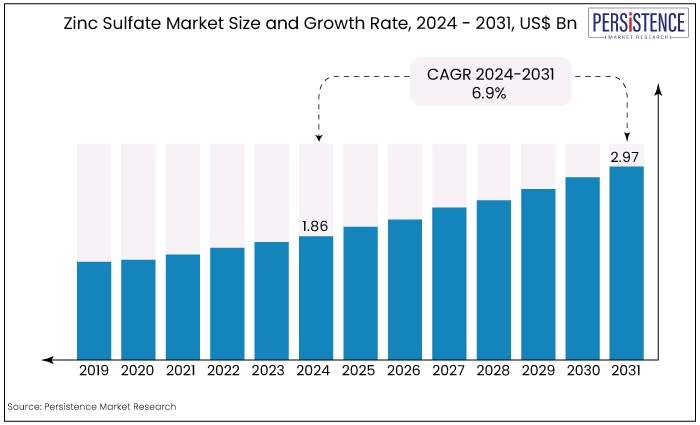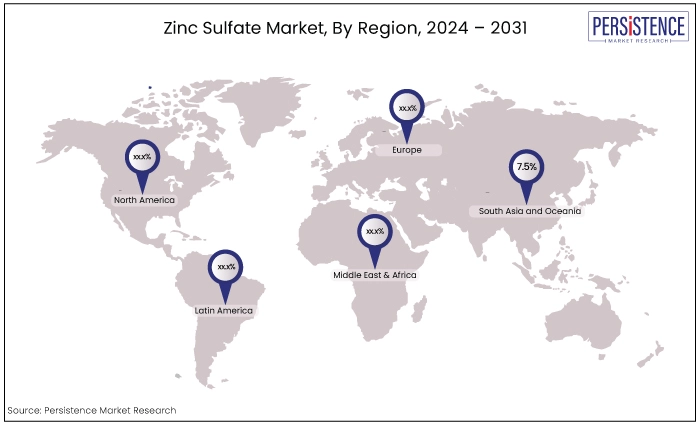Industry: Chemicals and Materials
Published Date: July-2024
Format: PPT*, PDF, EXCEL
Delivery Timelines: Contact Sales
Number of Pages: 195
Report ID: PMRREP34645
The global market for zinc sulfate is expected to reach a value of US$1.86 Bn by 2024. It is projected to grow at a CAGR of 6.9% from 2024 to 2031, reaching a market value of US$2.9 Bn by the end of forecast year.
Key Highlights of the Market
|
Market Attributes |
Key Insights |
|
Market Size (2024E) |
US$1.86 Bn |
|
Projected Market Value (2031F) |
US$2.97 Bn |
|
Forecast Growth Rate (CAGR 2024 to 2031) |
6.9% |
|
Historical Growth Rate (CAGR 2019 to 2023) |
6.1% |
Zinc sulfate plays a critical role across multiple industries, particularly agriculture, where it is a key fertilizer additive to address zinc deficiency in crops. Its high solubility and cost-effectiveness make it a staple in granular fertilizers.
As the global agriculture industry expands, driven by rising food demand in populous regions like India, and China, the use of such additives is set to increase. Beyond agriculture, zinc sulfate finds significant applications in the textile industry, enhancing fabric manufacturing processes and serving as a precursor to lithopone pigments.
Additionally, the growth in synthetic fiber production boosts its demand as a raw material. The product's utility extends to the pharmaceutical sector for addressing zinc deficiency and rayon fiber manufacturing, indicating a robust market trajectory ahead.

From 2019 to 2023, the zinc sulfate market experienced steady growth due to its essential role in agriculture, where it serves as a vital fertilizer additive to correct zinc deficiencies in crops.
The rising food demand, especially in populous regions such as India and China, propelled the use of zinc sulfate in granular fertilizers, driving market expansion.
Additionally, increased applications in the textile industry for fabric manufacturing and as a precursor to lithopone pigments supported market growth.
However, fluctuating zinc prices and environmental regulations regarding chemical usage in agriculture posed significant restraints, impacting the overall market dynamics.
Looking ahead to 2024-2031, the market is poised for continued expansion driven by ongoing agricultural development and the growing demand for synthetic fibers in the textile industry. The product’s role in manufacturing medicines for zinc deficiency, and the making of rayon fibers will further bolster its demand.
Emerging market trends such as the adoption of zinc sulfate in advanced textile treatments and eco-friendly agriculture practices are expected to shape future growth.
Market growth may face challenges from regulatory pressures on chemical use and potential competition from alternative micronutrient solutions, which could moderate the pace of expansion.
Shifting Market Focus, and Rising Importance in Pharmaceuticals
Zinc sulfate is essential in the pharmaceutical industry, commonly used in dietary supplements, medications, and skin treatments.
It is vital for addressing zinc deficiencies, crucial for immune health, and is found in lozenges for sore throats and creams for skin issues like acne due to its drying and antiseptic properties.
With increasing attention to health and wellness, the demand for zinc sulfate-based products is on the rise.
This demand is especially strong in rapidly growing markets like Brazil, China, and India, where pharmaceutical sales grew by 13.0%, 5.3%, and 11.0% respectively from 2017 to 2022, much higher than the 6.6% in the top five European Union countries and 7.1% in the US, according to the IQVIA MIDAS report, May 2023.
The emerging markets are attracting economic and research activities, shifting focus away from Europe. In 2022, North America accounted for 52.3% of the world’s pharmaceutical sales, with 64.4% of new medicines launched from 2017 to 2022 sold in the US compared to 16.4% in Europes top five markets.
Meanwhile, the fragmented EU market has led to significant parallel trade, valued at €6,280 million in 2021, which diverts funds away from R&D. These factors underscore the crucial role of zinc sulfate in the evolving pharmaceutical market, driving its global demand.
Thriving Market Demand for Anhydrous Zinc Sulfate
Anhydrous zinc sulfate is driving growth in the market due to its essential roles across diverse industries. In agriculture, it serves as a potent fertilizer additive, enriching soil with essential zinc nutrients that enhance crop yield and quality.
The application extends to the chemicals sector, where it acts as a crucial component in the production of dyes, pigments, and catalysts, supporting industrial processes and innovations.
Moreover, in pharmaceuticals, anhydrous type plays a vital role in the formulation of dietary supplements to combat zinc deficiency, addressing critical health concerns globally.
The increasing adoption of anhydrous type underscores its pivotal role in driving market expansion and creating lucrative opportunities across various industrial segments.
Growing Awareness About Harmful Effects of Pesticides
Increasing awareness of the harmful environmental and health effects of pesticides is challenging the growth of the market, particularly in agricultural applications where it is used as a micronutrient fertilizer.
End users are becoming more cautious about chemical inputs in agriculture, seeking organic and sustainable alternatives that minimize chemical residues in food products.
The shift in consumer preferences and regulatory pressures towards reducing pesticide use can restrict the adoption of zinc sulfate in conventional farming, impacting overall market expansion.
Challenges in Bioavailability and Nutritional Efficacy
Zinc sulfate supplements and agricultural formulations face limitations in absorption and effectiveness due to factors such as soil pH variations, interaction with other minerals, and suboptimal delivery methods.
Additionally, in regions with poor sanitation and unhygienic conditions, the benefits of zinc supplementation can be undermined by prevalent health issues, reducing the overall impact and demand for zinc sulfate-based products.
Boosting Crop Nutrition in Agriculture
Zinc sulfate is acts as a micronutrient in fertilizers to address zinc deficiencies in crops. As farmers increasingly adopt precision agriculture and micronutrient management practices, the role of zinc sulfate in enhancing crop yields, and improving soil health becomes crucial.
With global agricultural production intensifying to meet food security demands, especially in regions with zinc-deficient soils, the use of zinc sulfate in fertilizers is expected to expand, driving market growth.
Improving Water Treatment Efficiency
Zinc sulfate plays a critical role in water treatment processes as a coagulant to remove impurities and contaminants from water. With increasing regulatory standards for water quality and the growing need for efficient water treatment solutions in both municipal and industrial sectors, its application in water purification is expanding.
The push for sustainable and effective water treatment technologies is creating a favourable environment for the growth of product usage, enhancing its market presence in this vital sector.
|
Category |
Projected CAGR through 2031 |
|
Product Category - Heptahydrate |
6.4% |
|
End-user - Synthetic Fiber |
6.1% |
Significant Market Traction for the Heptahydrate Segment
The heptahydrate segment accounted for the significant market share of around 41.0% in 2023 and is likely to maintain its dominance during in the forthcoming years recording a CAGR of 6.4%. The segment stands out due to its versatile applications and widespread availability.
Zinc sulfate heptahydrate, characterized by its seven water molecules, is favoured in agriculture as a fertilizer and animal feed supplement, and in the chemical industry for producing various zinc compounds.
Its solubility and ease of handling make it ideal for diverse industrial processes. Its effectiveness in treating zinc deficiencies in crops and livestock enhances its demand, driving significant market traction.
The robust growth in agriculture and animal husbandry sectors, particularly in emerging economies, underscores the increasing importance and demand for heptahydrate globally. The chemical processing industry is likely to grow notably for zinc sulfate.
Demand Surges in Synthetic Fiber Production
Zinc sulfate is a component in the manufacturing of rayon. It contributes to the formation of the fiber structure and specific characteristics of rayon. It plays a pivotal role as a coagulating agent.
This compound is essential for transforming viscose into rayon fibers, a process critical for manufacturing various textiles used in clothing, home furnishings, and industrial applications.
As the demand for synthetic fibers grows, driven by their versatility, durability, and cost-effectiveness compared to natural fibers, its role in fiber production is becoming increasingly significant.
The expanding applications of synthetic fibers in diverse industries, such as automotive, medical textiles, and geotextiles, present substantial growth opportunities for market, making it a valuable component in the synthetic fiber market.
|
Region |
CAGR through 2034 |
|
South Asia and Oceania |
7.5% |
|
East Asia |
7.1% |
Pharma Industry Underpins Globally Significant Position of South Asia and Oceania
South Asia and Oceania is the most significant shareholder in the global market and is expected to grow at a CAGR of 7.5%. Region plays a pivotal role in driving the global market, primarily through robust industrial and agricultural activities.
In India, the pharmaceutical sector stands out as a major contributor, projected to grow significantly to reach US$130 Bn by 2030. India’s pharmaceutical prowess extends globally, supplying a substantial portion of generic drugs and vaccines, including essential immunizations recognized by the WHO.
The extensive production requires zinc sulfate for various pharmaceutical formulations, underpinning its crucial role in the industry. Simultaneously, countries agricultural sector, ranking second globally in food grain production and poised to expand further, relies on zinc sulfate for enhancing crop yields.
This agricultural application is crucial in addressing zinc deficiencies in soils, thereby supporting sustainable farming practices and ensuring food security.
Australia and New Zealand, known for their advanced agricultural practices and stringent quality standards, also drive demand for market. Both countries utilize product extensively in agriculture to improve soil health and livestock nutrition, contributing to high-quality food production.
These regions diverse industrial landscapes, from pharmaceuticals to agriculture and nutraceuticals, highlight zinc sulfates versatile applications and its integral role in driving economic growth and sustainability initiatives across South Asia and Oceania.
East Asia Expects Gains from China’s Chemical and Pharma Industry Growth
The East Asia zinc sulfate market is projected to secure a CAGR of 7.1% in the forecast period from 2024 to 2031. East Asia, particularly led by China, plays a pivotal role in driving the global market, driven by the region’s robust economic growth and industrial expansion.
China’s economy, forecasted to grow at an average of 4.4% from 2022 to 2030, is expected to outpace the US and EU, leading to increased healthcare spending and expanding access to pharmaceuticals.
The market growth here fuels the need for zinc sulfate in the production of medicines and dietary supplements, addressing zinc deficiencies and promoting wellness.
China’s unique market dynamics, characterized by its distinctive business models and advanced digital infrastructure, necessitate tailored strategies for market engagement, further driving demand in the pharmaceutical sector.
China chemical industry, the largest in the world, saw a 7.5% increase in production in 2022, reflecting its critical role in the global chemical market.
Zinc sulfate is a key component in various chemical manufacturing processes, supporting the production of numerous industrial chemicals and materials.
In contrast, other East Asian countries like Japan, and South Korea, experienced declines in chemical production, highlighting China’s dominant position.
As China’s chemical and pharmaceutical sectors continue to expand, the demand for zinc sulfate is expected to rise, reinforcing its essential role in East Asia's industrial landscape and contributing significantly to the global market.

The zinc sulfate market is highly competitive, with key manufacturers adopting various strategies to enhance their market positions. Companies like Piramal Pharma are expanding their product portfolios by introducing innovative solutions, such as the first generic zinc sulfate injection in the US market.
Redox is leveraging certifications and high rankings to boost its market credibility and distribution network, particularly in the Asia-Pacific region.
Concurrently, Nevada Zinc Corporation is focusing on scaling up production capabilities for high-grade zinc sulfate monohydrate through advancements in pilot plant technology, positioning itself to meet growing demands efficiently.
Such strategies reflect a trend towards product diversification, quality enhancement, and strategic scaling to capture market share.
March 2023
Nevada Zinc Corporation announced the successful continuous production of high-grade zinc sulfate monohydrate at its pilot plant project, initiated in March 2021 as a bench-scale test. Conducted by Hazen Research Inc. using samples from Nevada Zinc’s Lone Mountain property, this project achieved stable production of zinc sulfate monohydrate, a vital micronutrient fertilizer. The process, developed at the pilot plant, can be scaled up to meet the company’s future production targets using commercially available equipment.
August 2022
Piramal Pharma launched the first FDA-approved generic Zinc Sulfate Injection in the US under the Competitive Generic Therapy (CGT) designation, increasing competition for sole-source drugs.
|
Attributes |
Details |
|
Forecast Period |
2024 to 2031 |
|
Historical Data Available for |
2019 to 2023 |
|
Market Analysis |
US$ Billion for Value Tons for Volume |
|
Key Regions Covered |
|
|
Key Market Segments Covered |
|
|
Key Companies Profiled in the Report |
|
|
Report Coverage |
|
|
Customization & Pricing |
Available upon request |
By Type
By Application
By Region
To know more about delivery timeline for this report Contact Sales

The shift in market focus towards increasing importance in the pharmaceuticals sector.
Some of the key players operating in the market are Hindustan Zinc, Mepco, Rech Chemical Co. Ltd, Tianjin Xinxin Chemical Factory, Alpha Chemicals, Zinc Nacional, Ravi Chem Industries, Balaji Industries, and Tianjin Topfert Agrochemical Co.
The heptahydrate segment recorded the significant market share.
Enhancing water treatment efficiency through innovations to provide lucrative opportunities.
North America to account for the significant share of the market.